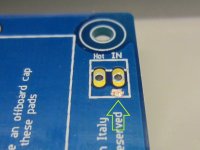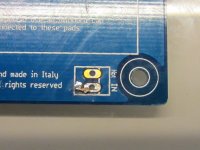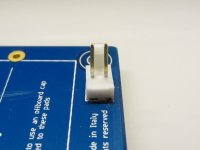I agree that short runs are the best sounding.
I once twisted the two (1.5mm) cores from twin & earth using a battery drill. I made two cables 5 meters long, tried them in my system and quickly removed them. A dull veiled sound with closed in/reduced sound stage was the result. Maybe the twist rate of roughly 1 turn per inch was to blame or less pure copper. The basic QED stuff i put back in was much better, it was/is the biggest difference i have heard between speaker cables to date.
I'd say it was probably more due to capacitance and resistance differences than copper purity but all three may well have played their part.
I once twisted the two (1.5mm) cores from twin & earth using a battery drill. I made two cables 5 meters long, tried them in my system and quickly removed them. A dull veiled sound with closed in/reduced sound stage was the result. Maybe the twist rate of roughly 1 turn per inch was to blame or less pure copper. The basic QED stuff i put back in was much better, it was/is the biggest difference i have heard between speaker cables to date.
I'd say it was probably more due to capacitance and resistance differences than copper purity but all three may well have played their part.
It seems that recommended relay for DC protection Omron G5LE-14-DC24 has gone out at Mouser currently. Wondering which is best alternative for it?
It seems that recommended relay for DC protection Omron G5LE-14-DC24 has gone out at Mouser currently. Wondering which is best alternative for it?
653-G5LE-1-DC24, same but not fully sealed.
Has anyone assembled their v1.7 boards yet?
Forgive me if I'm being real stupid but I cannot get any continuity from signal GND to any component on the board.
This is the same for both boards that are fully populated.
Forgive me if I'm being real stupid but I cannot get any continuity from signal GND to any component on the board.
This is the same for both boards that are fully populated.
Just de-soldiered the signal input connector and the IN pin (signal ground label under side) is floating, not attached to the ground plane that runs under C13.
Just checked on my yet to be completed 1.7 boards.
The signal ground on the input connector is unexpectedly floating as reported by BC108.
I'm really sorry, it seems that after redrawing the schematic for this last run the schematics' wires of the input connector, while apparently connected, they were not... 😡
This can be fixed with a perfect functional and aesthetic result, though.
Scrape a bit of solder mask near the ground pad (remain in the connector frame):

Solder a 2mm piece of copper wire (can be a trimmed wire from a resistor):

Invisible:

I've updated the build tutorial accordingly (it includes some other small fixes).
The signal ground on the input connector is unexpectedly floating as reported by BC108.
I'm really sorry, it seems that after redrawing the schematic for this last run the schematics' wires of the input connector, while apparently connected, they were not... 😡
This can be fixed with a perfect functional and aesthetic result, though.
Scrape a bit of solder mask near the ground pad (remain in the connector frame):
Solder a 2mm piece of copper wire (can be a trimmed wire from a resistor):
Invisible:
I've updated the build tutorial accordingly (it includes some other small fixes).
Attachments
Last edited:
Well, 4 hrs in and i think they are starting to open up a bit. Initial impressions (layman's) are very silent with no signal, snare and acoustic guitar attacks very well and the bass is controlled but prominent enough. Vocals are not harsh or have any, how can I say, hissing or shhhh'ing which I have experienced on lesser 3886 kits. Well done Dario, hats off to you!
(My setup if your interested - RPI3 -> Soekris DAM1021 Dac (with salas BiB regulators) -> lightspeed attenuator -> My_ref (stock BOM evo) -> IPL acoustics SM2 speakers (kit built out of 40mm solid walnut))
(My setup if your interested - RPI3 -> Soekris DAM1021 Dac (with salas BiB regulators) -> lightspeed attenuator -> My_ref (stock BOM evo) -> IPL acoustics SM2 speakers (kit built out of 40mm solid walnut))
Last edited:
Well, 4 hrs in and i think they are starting to open up a bit. Initial impressions (layman's) are very silent with no signal, snare and acoustic guitar attacks very well and the bass is controlled but prominent enough. Vocals are not harsh or have any, how can I say, hissing or shhhh'ing which I have experienced on lesser 3886 kits. Well done Dario, hats off to you!
I'm happy you like it 🙂
It will improve further as use time passes.
Will you upgrade some parts?
Last edited:
For output any AWG12 to AWG14 speaker cable will do but I suggest solid copper wire, preferably OCC and teflon insulated like Neotech SOCT [...]
A good low cost alternative is VanDamme LC-OFC 268-503-000
For input a good quality twisted pair like the ones from Amtrans [...] or a miniature balanced OFC cable like Mogami W2944 console cable (available from eBay or pro audio stores).
The Mogami is much cheaper but still very good.
Thanks for pointing me out the Mogami: I was near to use a coax cable (by Thender, OFC silver plated), but this one looks better for this job.
I can get some spare cable for output from my car : 2x2,5mmq Monacor OFC. I use in everyday, not bad really.
I'm happy you like it 🙂
It will improve further as use time passes.
Will you upgrade some parts?
Yes I'm sure some z foils are on the cards sometime soon. I have some Mundorf Mcap supreme's but in 2.2 uf. I know fundamentally it will just lower the cut off frequency but will it effect the sound?
Yes I'm sure some z foils are on the cards sometime soon.
Fine, remember that some (other) parts should be upgraded first for best results (like Amtrans over FKP2s or Cerafine over KZ)
I have some Mundorf Mcap supreme's but in 2.2 uf. I know fundamentally it will just lower the cut off frequency but will it effect the sound?
According Penasa (the designer of the orginal My_Ref) the value has a role (and effect) on LM318.
Sincerely I never heard any difference using higher value caps (up to 1.5uF) but keep in mind that a 2.2uF will be way (physically) bigger so it will not mount perfectly and could pick up more noise.
The DC blocking cap will have no effect on the LM318, other than to roll off bass if the value is too small.
Speaker cable result, now got 3 Meter runs of this stuff (off the reel from an ebay shop) - QED Ruby Anniversary Evolution
Improved clarity, definition and tighter bass. Not huge differences but quite noticeable. Wish i paid a bit more for pre-terminated though cos it's not nice to work with.
Changing interconnects doesn't make any noticeable difference in my current system but changing speaker cable does.
Improved clarity, definition and tighter bass. Not huge differences but quite noticeable. Wish i paid a bit more for pre-terminated though cos it's not nice to work with.
Changing interconnects doesn't make any noticeable difference in my current system but changing speaker cable does.
Continuing the full diy theme, im using UBYTE-2 cables. Have quite a high capacitance but I opted for the evo version to compensate.
Just swapped back to some standard side by side cable to jog my memory and it doesn't sound as open or as detailed as the UBYTE-2.
Just swapped back to some standard side by side cable to jog my memory and it doesn't sound as open or as detailed as the UBYTE-2.
Now that you have better speaker cables, try again... using RG400 coax cable. 😉Changing interconnects doesn't make any noticeable difference in my current system but changing speaker cable does.
(but make sure to get a genuine one by some well known, good manufacturer from a trustworthy RF hardware shop. Stay away from the no-brand ones often found on eBay).
Inviato dal mio GT-I9100 utilizzando Tapatalk
- Home
- Amplifiers
- Chip Amps
- My_Ref Fremen Edition - Build thread and tutorial



